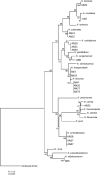Biodegradation of polycyclic aromatic hydrocarbons, phenol and sodium sulfate by Nocardia species isolated and characterized from Iranian ecosystems
- PMID: 33318531
- PMCID: PMC7736881
- DOI: 10.1038/s41598-020-78821-1
Biodegradation of polycyclic aromatic hydrocarbons, phenol and sodium sulfate by Nocardia species isolated and characterized from Iranian ecosystems
Abstract
Anthropogenic pollutants are known to have adverse effect on ecosystem, biodiversity and human health. Bioremediation is an option that has been widely used to remediate organic contaminants and reduce the risk of these hazardous materials. Microorganisms are readily available to screen and can be rapidly characterized to be applied in many extreme environmental conditions. Actinomycetes have a great potential for the production of bioactive secondary metabolites which have biodegradation activity. This study aimed to screen and characterize Nocardia species with biodegradation potential from diverse Iranian ecosystems. The isolates were screened from 90 collected environmental samples, identified and characterized using conventional and molecular microbiological methods including the PCR amplification and sequencing analysis of 16S rRNA and rpoB genetic markers. Growth rate in presence of pollutants, chromatography, Gibbs and turbidometric methods were used to determine bioremediation ability. A total of 19 Nocardia isolates were recovered from the cultured samples (21.1%) that belonged to 10 various species. The most prevalent Nocardia species was N. farcinica; 4 isolates (21%), followed by N. cyriacigeorgica and N. cashijiensis like; 3 isolates each (15.7%) and N. asteroides and N. kroppenstedtii; 2 isolates each (10.5%). Our results showed that various Nocardia species have great potential for bioremediation purposes, although they have not received much attention of the scholars for such significant usage.
Conflict of interest statement
The authors declare no competing interests.
Figures






References
-
- Kumar A, Bisht B, Joshi V, Dhewa T. Review on bioremediation of polluted environment: A management tool. Int. J. Environ. Sci. 2011;1:1079.
-
- KENSA, V. M. Bioremediation—an overview. I Control Pollution2011 (2015).
-
- de Lorenzo V, Loza-Tavera H. Microbial bioremediation of chemical pollutants: How bacteria cope with multi-stress environmental scenarios. Bacter. Stress Resps. 2010;2:481–492.
-
- Storz, G. & Hengge-Aronis, R. Bacter stress resps. Vol. 791 (Wiley Online Library, 2011).
-
- Zorádová S, Dudášová H, Lukáčová L, Dercová K, Čertík M. The effect of polychlorinated biphenyls (PCBs) on the membrane lipids of Pseudomonas stutzeri. Intern. Biodeter. Biodegrad. 2011;65:1019–1023. doi: 10.1016/j.ibiod.2011.03.012. - DOI
Publication types
MeSH terms
Substances
LinkOut - more resources
Full Text Sources

